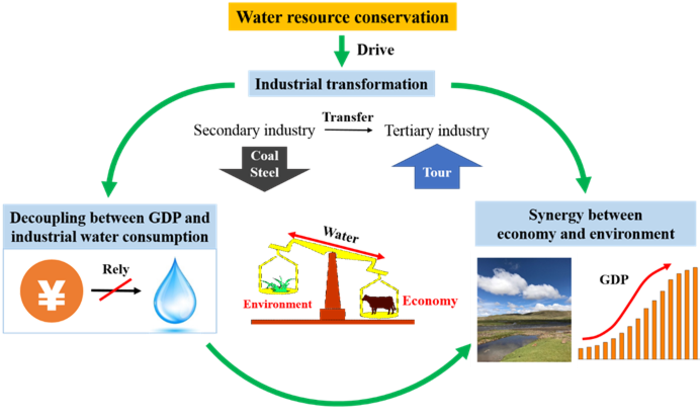As far as drylands are concerned, water resource availability is the significant limiting factor for endurable development. Northern China’s drylands consist of just 19% of the country’s complete water resources but house one-third of the national population, and are thus under substantial water stress.
 Water Resource Conservation Promotes Synergy Between Economy and Environment Through Industrial Transformation in Inner Mongolia. Image Credit: Higher Education Press Limited Company.
Water Resource Conservation Promotes Synergy Between Economy and Environment Through Industrial Transformation in Inner Mongolia. Image Credit: Higher Education Press Limited Company.
Inner Mongolia, which is a normal dryland province, plays a significant role in retaining ecological security in northern China. Over the last few years, its anthropogenic water consumption has gone up four-fold, from 6.68 billion m3 in 1987 to 27.11 billion m3 in 2015.
This increase has seriously endangered regional grasslands, which also depend on water resources to retain ecological integrity.
The dispute between social-economic and ecological systems and the actions that might ease it has been ignored for a long time. This might result in sudden issues when adopting policies with a one-sided focus.
The contradictory water demands have been escalated by the climate change between people and the environment and stress the significance of effective water resource management for obtaining a balance between environmental safety and economic development.
In 2008, Inner Mongolia suggested rigorous regulations on water exploitation and utilization that have been targeted at obtaining sustainable development. By adopting such regulations, Inner Mongolia’s government aims to restrict high water consumption and the expansion of polluting industries.
By doing so, the researchers aim to obtain industrial restructuring toward sustainable development. But no systematic evaluation has been performed till now to identify if and how such severe regulations on water conservation might ease the tension between economic development and environmental protection. Without this data, policy adjustment and the potential to obtain sustainable development are restricted.
Currently, a research team from the University of Chinese Academy of Sciences studied the performance and effectiveness of these long-lasting water conservation regulations. The study outcomes were reported in the Frontiers of Environmental Science & Engineering journal.
The researchers found that the regulations drove industrial transformation, which is illuminated by the reducing proportion of environmentally harmful industries like coal and steel, and the growing proportion of tertiary industries (particularly tourism).
After industrial transformation, economic development dissociated from industrial water consumption and later resulted in decreased negative environmental effects.
Based on these outcomes, adaptive strategies were developed for 12 cities by disclosing and combining their development pathways and comparative status in obtaining sustainable development.
Incorporation and cooperation between cities were suggested, for example, a water trade agreement between central Inner Mongolia (an economically developed region with great water stress) and eastern Inner Mongolia (an economically underdeveloped region with comparatively abundant water resources).
Across regions, such an agreement might allow the holistic achievement of sustainable development. Combining the outcomes of the study helped develop a reproducible framework that has been set up for water-management-based sustainable development plans in drylands.
By making use of the regulations of water resources, stimulating the internal motivation of industrial transformation could help obtain synergy between economic development and environmental safety. This boasts endurable development in drylands.
Collectively, three suggestions are given for sustainable development in drylands:
- Limit the water exploitation and control the water cost to conciliate the conflict between the economy and environment
- Encourage novel technologies to increase the efficiency of water use
- Improve regional cooperation obtain holistic development in a mutually profitable manner.
Journal Reference:
Liu, Y., et al. (2022) Water resource conservation promotes synergy between economy and environment in China’s northern drylands. Frontiers of Environmental Science & Engineering. doi.org/10.1007/s11783-021-1462-y